
Aquatic Weed ID Guide
Our Weed ID Guide is designed to help you identify common aquatic plants—both beneficial and invasive—so you can make informed decisions about managing your pond or lake. Whether you’re dealing with aggressive invaders like phragmites or simply want to maintain a balanced ecosystem, understanding the plants in your lake or pond is the first step. Explore our guide to learn more about different species, their impact, and the best strategies for control.
Need help? Send us a picture!
Non-Native: Non-native species are those that occur outside their natural range boundaries. This is often mediated by humans either deliberately or unintentionally.
Invasive: An invasive species is a species that is non-native to the ecosystem under consideration and whose introduction causes or is likely to cause economic or environmental harm or harm to human health.
American Pondweed
American pondweed, also known as long-leaf pondweed, is a submerged aquatic plant with distinctive floating, sword-shaped leaves. It is commonly found in ponds and lakes, where its broad, floating leaves create a mat on the water’s surface while its stems and roots remain anchored below. This plant provides habitat and food for fish and wildlife, but excessive growth can hinder water circulation and recreational use. Effective management is best achieved in the early stages of development, before the formation of nutlets and seed dispersal, to prevent uncontrolled spread and maintain a balanced aquatic ecosystem.

Anabaena
Anabaena is a type of cyanobacteria, commonly referred to as blue-green algae, that can form floating mats or scums on the surface of lakes and ponds. Often observed as blue or green in color, this cyanobacteria thrives in warm, nutrient-rich waters, especially during late summer and early fall. In addition to impacting water clarity and aesthetics, Anabaena has been linked to human and animal illnesses, often resulting in symptoms such as vomiting, diarrhea, and abdominal pain. Some species can produce harmful toxins that pose risks to fish, wildlife, and even drinking water supplies. Managing nutrient levels and promoting healthy water circulation are key strategies for controlling Anabaena growth and maintaining a balanced aquatic ecosystem.

Arrowhead
Arrowhead, also known as duck potato, is a perennial aquatic plant commonly found along the edges of ponds and wetlands, often growing in dense stands. It features distinctive arrow-shaped leaves that can reach 2–3 feet tall, along with striking white blooms that appear in late summer. This hardy plant has strong, tuberous roots that allow it to withstand fluctuating water levels and varying weather conditions. While Arrowhead provides valuable habitat and food for wildlife, including waterfowl, its rapid growth can sometimes require management to prevent excessive spread along shorelines.

Azolla Fern
Azolla fern is a small, free-floating aquatic plant that forms dense mats on the water’s surface. Each plant features tiny, overlapping leaves and thread-like roots that dangle beneath the water. While typically green, Azolla can turn a reddish-brown color under certain conditions, such as high sunlight or cooler temperatures. This plant spreads rapidly, with the ability to double its concentration in just seven days, making it highly invasive. If left unmanaged, Azolla can block sunlight, reduce oxygen levels, and disrupt the balance of aquatic ecosystems. Proper management is essential to prevent excessive growth and maintain healthy water conditions.

Bladderwort
Bladderwort is a free-floating aquatic plant with finely divided, feathery leaves and no visible roots. It gets its name from the small, bladder-like structures found on its leaves, which function as tiny traps to capture and consume aquatic invertebrates. This carnivorous adaptation helps the plant obtain nutrients in nutrient-poor waters. While beneficial for natural water filtration and providing habitat for aquatic life, excessive growth can sometimes require management to maintain open water areas and prevent interference with recreational activities.

Brazilian Elodea
Brazilian elodea, often referred to as anacharis, is an invasive submerged aquatic plant known for its rapid growth and ability to form dense underwater mats. It has bright green leaves arranged in whorls of 4–6 with relatively smooth edges. This aggressive species spreads easily and can quickly crowd out native vegetation, disrupt water flow, and interfere with recreational activities like fishing and boating. Due to its fast growth and resilience, early detection and management are essential to prevent its establishment and protect the health of aquatic ecosystems.
⚠️ Invasive Species

Brittle Naiad
Brittle naiad is an invasive submerged aquatic plant that often grows in dense clumps, creating a bushy appearance underwater. Its long, pointed leaves have distinct spines and are oppositely arranged along the stem. As its name suggests, the plant is fragile and breaks apart easily, allowing fragments to spread and establish new growth rapidly. This aggressive species can outcompete native vegetation, disrupt aquatic ecosystems, and interfere with recreational activities. Early detection and management are key to preventing its spread and maintaining a balanced water environment.
⚠️ Invasive Species
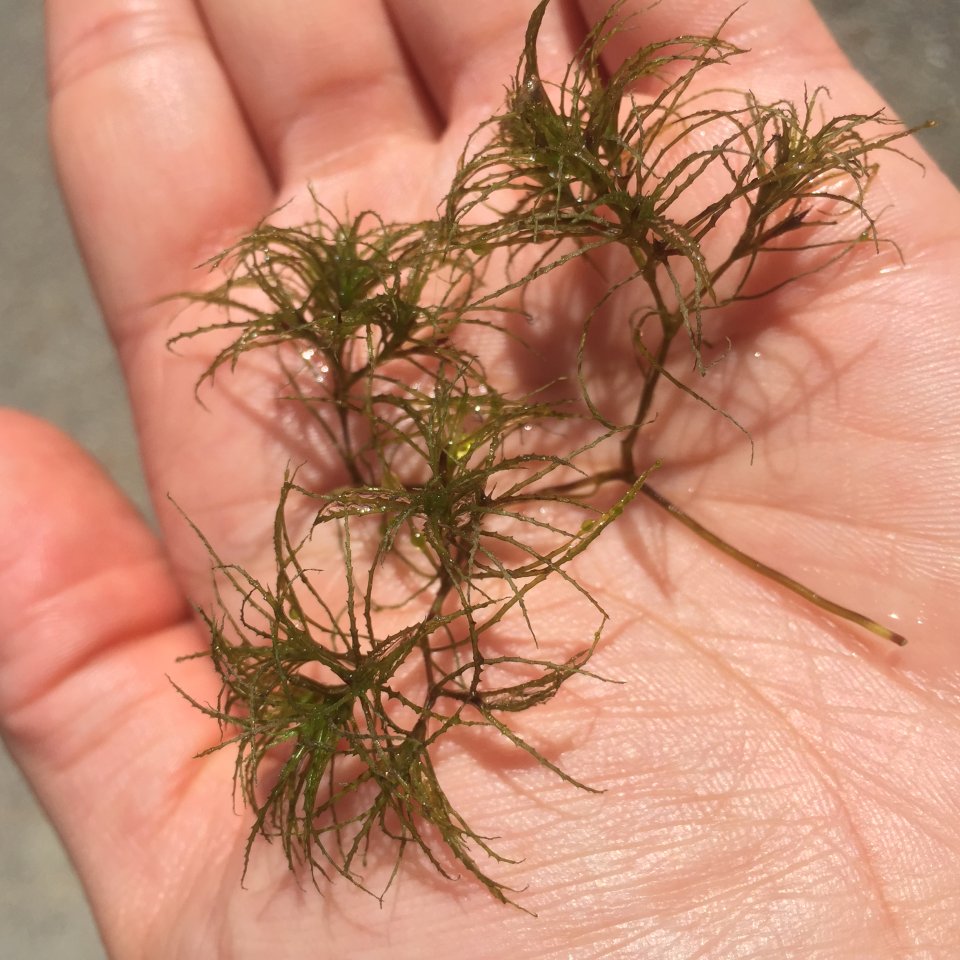
Bulrush
Bulrush is a native wetland sedge that grows 2–4 feet tall and thrives along shorelines and in shallow water. With the ability to form dense stands, it plays a crucial role in stabilizing shorelines, reducing erosion, and providing habitat for aquatic wildlife. Its unbranched, grass-like stems often end in tight clusters of flowers and seeds, which support waterfowl and other species.

Cabomba
Cabomba is a submerged aquatic plant recognized for its delicate, fan-shaped leaves that are oppositely arranged along the stem. Each submerged leaf is finely dissected into narrow segments, while occasional undissected leaves may float on the water’s surface. This plant can spread rapidly, forming dense underwater mats that compete with native vegetation, reduce water flow, and interfere with recreational activities. Due to its fast growth and ability to propagate through fragments, early detection and proper management are essential to prevent its spread and maintain a balanced aquatic ecosystem.
⚠️ Invasive Species

Chara Algae
Chara is an advanced form of algae often mistaken for a true aquatic plant due to its complex structure. It is best identified by its musky odor and gritty texture, which comes from calcium deposits on its surface. Unlike rooted plants, Chara attaches to the lake bottom but does not develop true roots. It can form dense underwater growths that cover large areas, providing habitat for fish and helping to stabilize sediments. While beneficial in moderation, excessive growth can reduce water flow, interfere with recreation, and require management to maintain a balanced aquatic ecosystem.

Clasping-leaf Pondweed
Clasping-leaf pondweed is a submerged aquatic plant characterized by its broad, wavy leaves that wrap around the stem, extending three-quarters of the way around it. The leaves are alternately arranged along the stem, with the upper portions appearing more branched and leafy. This native pondweed provides valuable habitat and food for fish and waterfowl, contributing to a healthy aquatic ecosystem. While generally beneficial, excessive growth in nutrient-rich waters can lead to dense stands that may require management to maintain open water and recreational access.

Common Reed
Common reed is a highly invasive perennial grass that thrives in wetlands across North America. Growing up to 15 feet tall, it forms dense stands that aggressively outcompete native vegetation, reducing plant diversity and altering wetland ecosystems. Its rapid spread, aided by an extensive root system, can disrupt shorelines, hinder water flow, and degrade wildlife habitats. Effective management is crucial to control its expansion and protect the health of aquatic environments.
⚠️ Invasive Species

Coontail
Coontail is a fully submerged aquatic plant commonly found in hard water across the continental United States. It lacks true roots and freely drifts in the water column, though it can anchor itself in soft sediments. Its dark green, forked leaves are arranged in whorls along the stem, giving it a bushy, coon-tail-like appearance. Coontail can spread aggressively, forming dense underwater mats that interfere with water flow, recreation, and native vegetation. Due to its resilience, controlling coontail can be challenging and may require multiple herbicide applications for effective management.

Creeping Water Primrose
Creeping water primrose is an aquatic and wetland plant commonly found in shallow water or moist soils. It features a hollow red stem with numerous green and red leaves, spreading aggressively along shorelines and wetland areas. This plant is easily identified by its bright yellow flowers, which help distinguish it from similar species. While creeping water primrose provides some habitat benefits, its rapid growth can quickly lead to dense mats that choke out native vegetation, restrict water flow, and interfere with recreational activities. Early detection and management are essential to prevent excessive spread.
⚠️ Invasive Species

Curly-leaf Pondweed
Curly-leaf pondweed is an invasive submerged aquatic plant easily identified by its green leaves with a reddish hue and distinctive wavy, crinkled edges. Unlike many aquatic plants, it thrives in early spring, growing aggressively before most native pondweeds become active. This early-season growth allows it to form dense underwater mats that can outcompete native vegetation, reduce water quality, and interfere with recreational activities. Managing curly-leaf pondweed early in its growth cycle is key to preventing its spread and maintaining a balanced aquatic ecosystem.
⚠️ Invasive Species

Duckweed
Duckweed is a small, free-floating aquatic plant that is often mistaken for algae. It has tiny green leaves with a 1–2 inch thread-like root that dangles beneath the water’s surface. This plant thrives in older, nutrient-rich ponds and can rapidly multiply, forming dense mats that cover the entire water surface. When left unmanaged, duckweed can block sunlight from reaching submerged plants, deplete oxygen levels, and potentially lead to fish kills. Proper management, including nutrient control and aeration, is essential to prevent excessive growth and maintain a healthy aquatic ecosystem.

Eelgrass
Eelgrass is a submerged aquatic plant with long, ribbon-like leaves that sway with water movement. It spreads through a horizontal stem system that connects tufts of leaves, allowing it to form dense underwater meadows. A hybrid variety, found in the Tennessee River Valley, exhibits aggressive growth characteristics, making it more challenging to control. Blooming in late summer, eelgrass can reach the water’s surface, where it often impedes recreational activities such as boating and swimming. While it provides essential habitat and oxygenation benefits, excessive growth—particularly from the hybrid variety—may require active management to maintain open waterways and prevent obstructions.

Euglena
Euglena are unicellular microorganisms commonly found in nutrient-rich ponds and lakes. Under certain conditions, they can cause water to take on a reddish-brown hue, often mistaken for harmful algal blooms. The severity and frequency of these red blooms are largely influenced by phosphorus levels in the water column. While Euglena play a role in aquatic ecosystems, excessive growth can indicate water quality imbalances. Managing nutrient inputs, particularly phosphorus, is key to preventing these blooms and maintaining a healthy aquatic environment.

Eurasian Watermilfoil
Eurasian watermilfoil is one of the most aggressive and problematic aquatic weeds found in ponds and lakes. It has reddish stems with delicate, fan-shaped leaves arranged in whorls around the stem. This invasive plant spreads rapidly, primarily through fragmentation, where small pieces break off and establish new growth. Once introduced, Eurasian watermilfoil can form dense underwater mats that outcompete native vegetation, reduce biodiversity, and interfere with recreational activities such as boating, fishing, and swimming. Early detection and consistent management are essential to prevent its spread and maintain a balanced aquatic ecosystem.
⚠️ Invasive Species

Filamentous Algae
Commonly known as pond scum or moss, filamentous algae form dense, tangled mats on the water’s surface. Growth typically begins along the pond bottom or edges before rising to the surface, buoyed by the oxygen produced during photosynthesis. While filamentous algae are a natural part of aquatic ecosystems, excessive growth can reduce oxygen levels, disrupt water flow, and interfere with recreation. Managing nutrient levels and promoting water circulation are key strategies for controlling its spread and maintaining a healthy pond or lake.
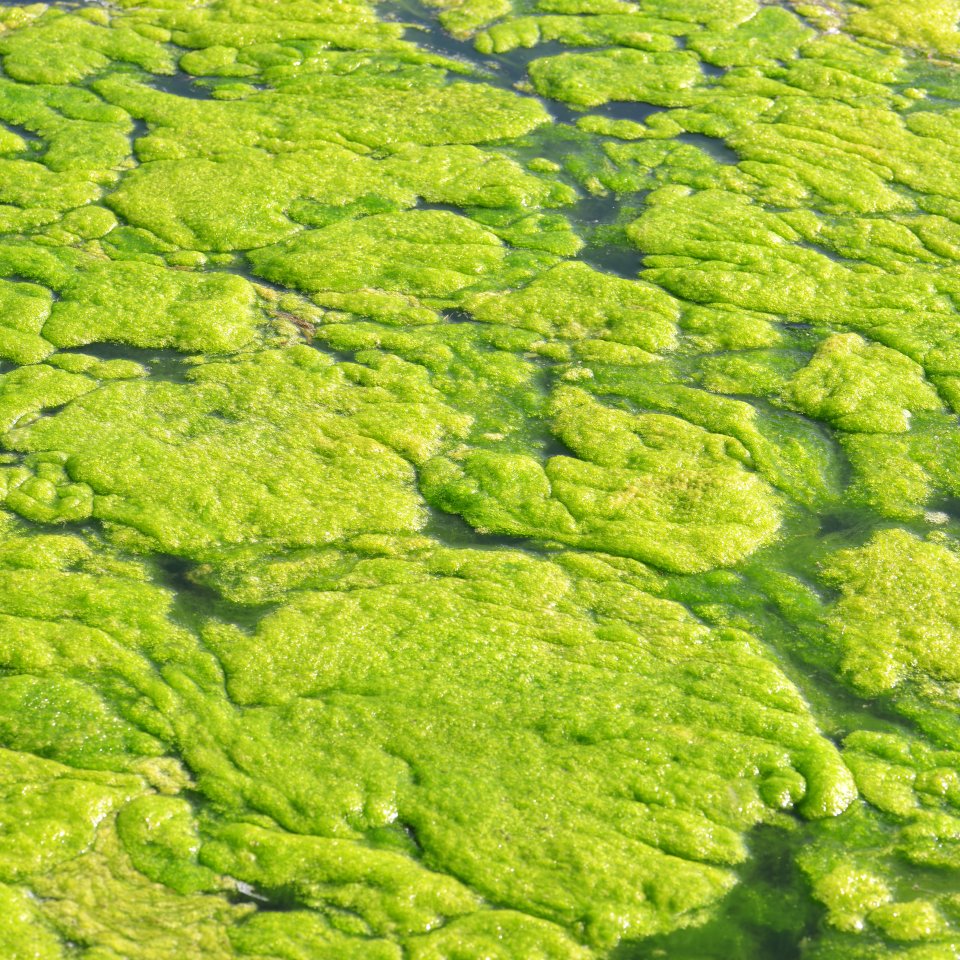
Floating Heart
Floating heart is an aquatic plant that produces distinctive yellow flowers standing 1–3 inches above the water’s surface. Its slightly variegated, heart-shaped leaves resemble small water lily pads, creating a dense floating canopy. This plant spreads rapidly through an extensive root system, allowing it to take over ponds and slow-moving waterways. While it provides some habitat benefits, its aggressive growth can crowd out native vegetation, reduce water circulation, and interfere with recreational activities. Early detection and management are essential to prevent excessive spread and maintain a balanced aquatic ecosystem.
⚠️ Invasive Species

Hydrilla
Hydrilla is an invasive submerged aquatic plant that poses a significant threat to lakes, ponds, and waterways across much of the United States. It has slender stems with leaves arranged in whorls of 4–8, featuring toothed margins and a toothed mid-rib. Hydrilla spreads aggressively through fragmentation, stolons, and hardy underground tubers that can survive winter conditions, making it extremely difficult to control. Once established, it forms dense mats that outcompete native vegetation, reduce oxygen levels, and interfere with recreational activities like boating and fishing. Early detection and proactive management are crucial to preventing its spread and protecting aquatic ecosystems.
⚠️ Invasive Species

Lotus
Lotus is a hardy aquatic plant that thrives in sunny, shallow water and can spread rapidly under the right conditions. Its broad, circular leaves and striking blooms rise 3–5 feet above the water’s surface, creating a dramatic visual impact. Its aggressive growth can quickly become a nuisance, overtaking ponds and wetlands. Effective management is best achieved during the summer months when the plant is actively growing, helping to control its spread and maintain a balanced aquatic environment.
⚠️ Invasive Species

Microcystis
Microcystis is a colonial cyanobacteria commonly referred to as a slick or film due to its ability to form surface scums. Its buoyant cells accumulate along shorelines, particularly in windward areas, and are most frequently observed in nutrient-rich ponds during mid to late summer. Some Microcystis blooms produce toxins that can cause skin irritation and gastrointestinal distress upon contact or ingestion. To minimize health risks, it is advisable to avoid contact with affected water and implement nutrient management strategies to help prevent excessive bloom formation.

Narrowleaf & Hybrid Cattail
Narrowleaf and hybrid cattails are tall, grass-like wetland plants that thrive in lowland areas, pond perimeters, and detention basins, growing in water up to 4 feet deep. These plants can reach heights of up to 10 feet, with mature specimens producing distinctive brown catkins in mid-summer. Both narrowleaf and hybrid cattails are often mistaken for the native common cattail but tend to spread more aggressively, forming dense stands that can outcompete native vegetation. Their rapid expansion can impact wetland ecosystems and water management structures, requiring management to maintain biodiversity and prevent excessive encroachment into open water areas.
⚠️ Invasive Species

Oscillatoria
Oscillatoria is a filamentous cyanobacteria that forms small, spongy masses on the bottom of ponds and lakes before eventually floating to the surface. It is often dull gray in color and can be difficult to control once established. This troublesome cyanobacteria thrives in nutrient-rich waters and can contribute to poor water quality, including oxygen depletion and toxin production in some cases. Managing nutrient inputs and promoting water circulation are key strategies for preventing excessive growth and maintaining a balanced aquatic ecosystem.

Parrotfeather
Parrotfeather is an invasive aquatic plant that thrives along pond edges, often trailing across the water’s surface. Its deeply cut, feathery-looking leaves are bright blue-green and arranged in whorls of 4–6 around the stem. This plant spreads rapidly, forming dense mats that can choke out native vegetation, reduce water flow, and interfere with recreational activities. Due to its aggressive growth and ability to regenerate from fragments, early detection and proper management are essential to prevent its spread and maintain a balanced aquatic ecosystem.
⚠️ Invasive Species

Purple Loosestrife
Purple loosestrife is a highly invasive wetland plant that can reach heights of 6–7 feet. It is easily recognized by its bright purple flowers, which grow in dense spikes at the ends of its four-sided stems. The leaves are typically arranged in opposite pairs along the stem. This aggressive species spreads rapidly, primarily through prolific seed production, outcompeting native vegetation and disrupting wetland ecosystems. Effective management is crucial, with early intervention recommended before the plant sets seed to prevent further spread and preserve native plant diversity.
⚠️ Invasive Species

Sago Pondweed
Sago pondweed is a submerged aquatic plant with a bushy appearance, characterized by its narrow, thread-like leaves arranged alternately along the stem. This plant is widely recognized as an essential food source for waterfowl, providing both habitat and nutrition in aquatic ecosystems. While beneficial in moderation, sago pondweed can grow aggressively under certain conditions, sometimes requiring management to prevent excessive spread that could interfere with water flow and recreational activities.

Scouring Rush
Scouring rush, also known as rough horsetail, is an ancient perennial plant characterized by its tall, slender, jointed stems that can reach heights of 2–5 feet. These dark evergreen, hollow stems are ridged and rough to the touch due to silica deposits, which historically made them useful for scouring pots and polishing metal . The high silica content also contributes to the plant’s resistance to herbicides, making it challenging to control . Scouring rush typically grows in moist to wet soils, often forming dense colonies through its robust rhizome system .

Small Pondweed
Small pondweed is a perennial, submerged aquatic plant commonly found along shorelines and in water depths of up to 8 feet. It features thin, flexible stems with slender, ribbon-like leaves arranged alternately. While this plant provides habitat and food for aquatic wildlife, it can form dense clumps that may hinder fishing, boating, and other recreational activities. In nutrient-rich waters, small pondweed can spread rapidly, sometimes requiring management to maintain open water areas and balance aquatic ecosystems.

Southern Naiad
Southern naiad is a submerged aquatic plant with slender stems and leaves that are arranged oppositely or in whorls of three. The leaves are wider at the base, with visible spines along the margins, and often conceal tiny seeds at the leaf axis. This plant thrives in a variety of water conditions and frequently grows in thick, dense beds that can be difficult to control. While it provides habitat and food for fish and waterfowl, excessive growth can interfere with water flow, recreation, and native vegetation, sometimes requiring management to maintain a balanced aquatic ecosystem.

Spatterdock
Spatterdock is a large, water lily-like aquatic plant with heart-shaped leaves that can float on the water’s surface or remain partially submerged. It produces distinctive round, yellow flowers that are smaller than golf balls. This plant spreads aggressively through both seed production and its large, spongy rhizomes, allowing it to establish dense colonies. While spatterdock provides valuable habitat for fish and wildlife, excessive growth can impede water flow and recreational activities. Due to its resilient nature, control often requires multiple herbicide treatments for effective management.
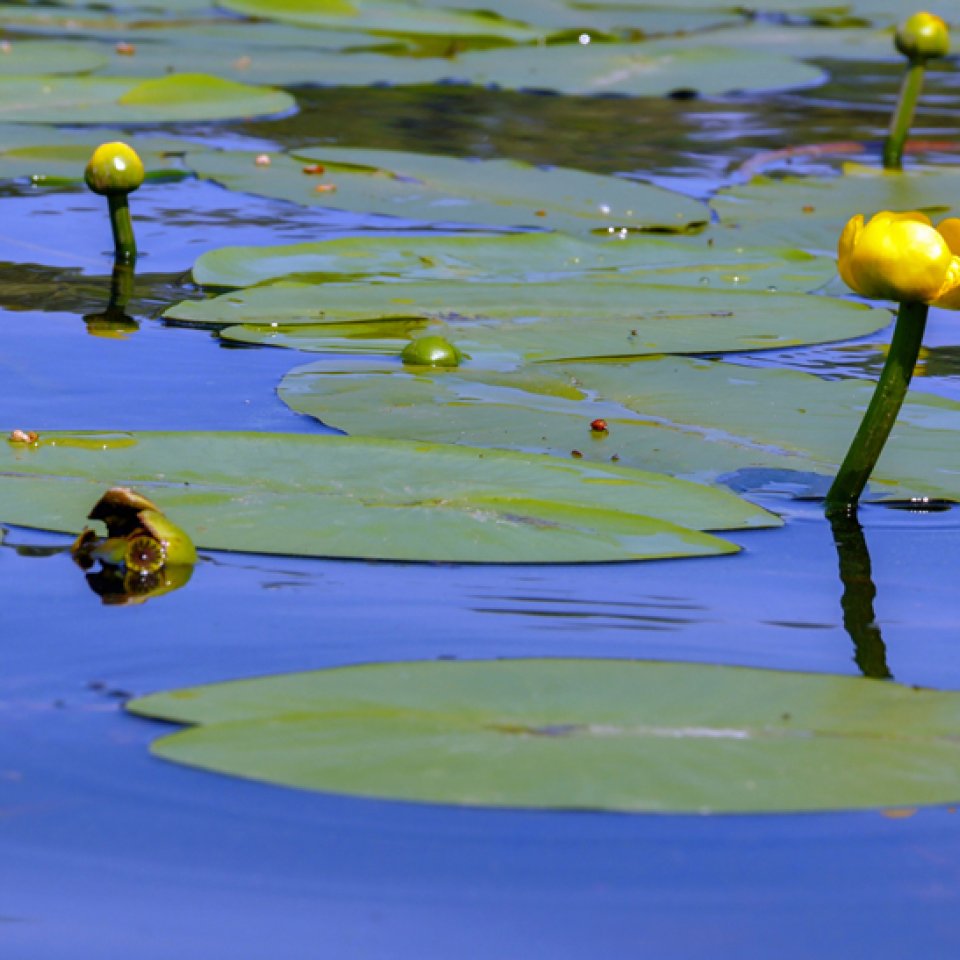
Spearwort
Spearwort is a wetland plant commonly found in marshy areas, where it thrives in moist soils and shallow water. It is easily identified by its shiny, yellow flowers with egg-shaped petals that grow on reddish-green stalks. The plant can range in height from 4 to 48 inches, with few shoots emerging from the main stem. While spearwort adds visual appeal to wetland environments, its growth may need management in certain areas to prevent it from overtaking native vegetation or obstructing water flow.

Spike Rush
Spike rush is a wetland plant characterized by its green, leafless stems that range in height from 5 inches to 4 feet. It grows in clumps and is easily recognized by the small brown spikelets at the tip of each stem. Typically found along shorelines and in shallow water, spike rush plays an important role in stabilizing soil and providing habitat for aquatic wildlife. While beneficial for erosion control, it can spread aggressively in some environments, sometimes requiring management to maintain balanced aquatic and shoreline ecosystems.
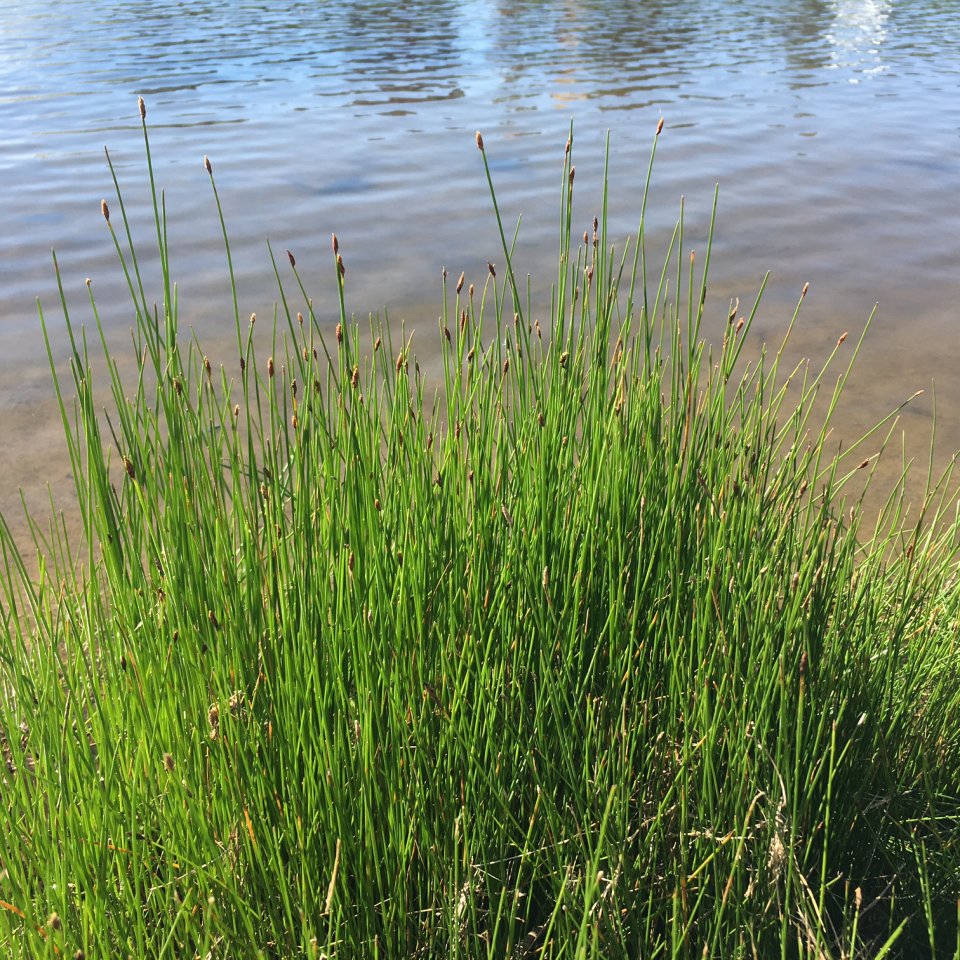
Swamp Iris
Swamp iris, also known as yellow flag iris, is one of the first plants to bloom in spring, producing striking yellow flowers that rise above its tall, sword-shaped leaves. These vibrant blooms typically continue throughout May, adding a splash of color to wetlands, shorelines, and other moist environments. While swamp iris is visually appealing and provides some habitat benefits, it spreads rapidly through both seeds and rhizomes, potentially outcompeting native vegetation. In some areas, management may be necessary to prevent excessive growth and maintain ecological balance.
⚠️ Invasive Species
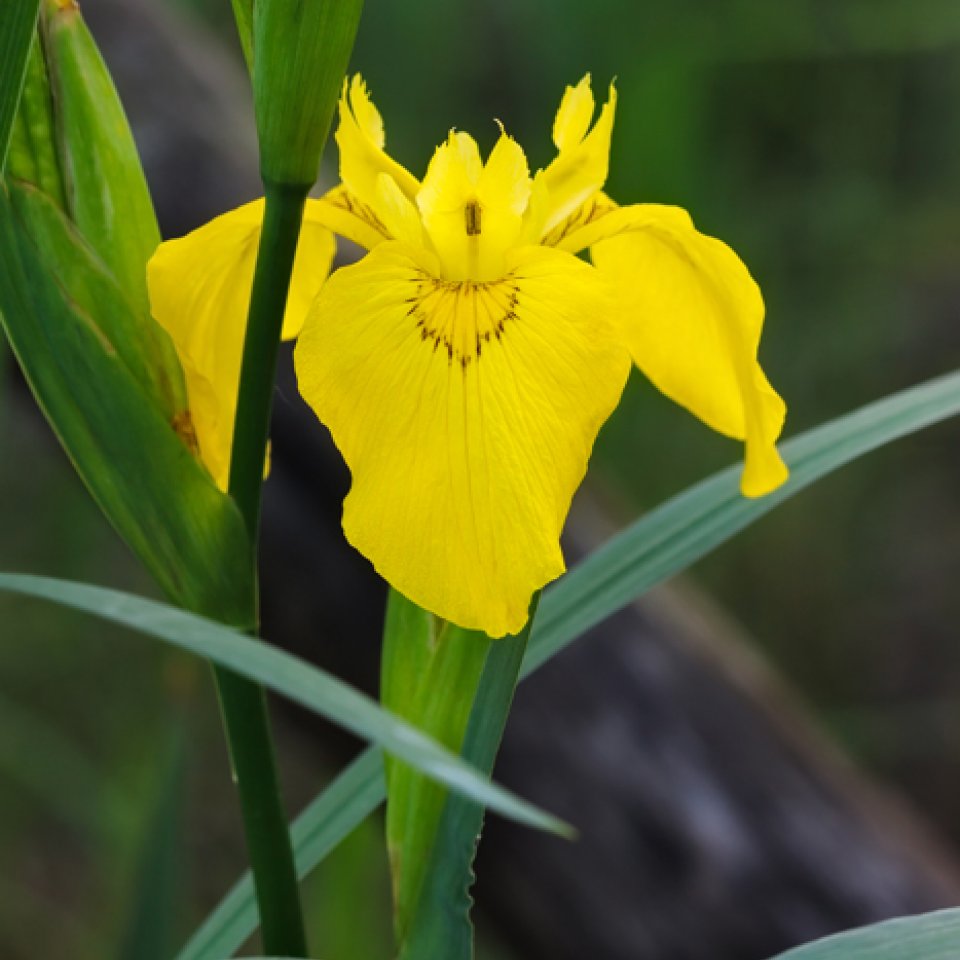
Water Clover
Also known as European water clover, this aquatic invasive species was likely introduced to the United States through the aquarium trade. Water clover thrives in shallow waters with muddy or sandy bottoms, where it can either rest on the water’s surface or stand just above it. Its distinctive four-leaf clover-like appearance makes it easy to identify, but its rapid spread can crowd out native vegetation and disrupt aquatic ecosystems. Early detection and management are essential to prevent its uncontrolled expansion and protect native plant diversity.
⚠️ Invasive Species

Water Lettuce
Water lettuce is a free-floating aquatic plant that thrives in ponds, lakes, canals, and rivers, where it quickly forms large, dense mats. Its rapid reproduction can obstruct water flow, degrade water quality, and impede recreational activities such as boating and fishing. While water lettuce spreads aggressively in warm climates, it does not survive winter in regions that experience freezing temperatures. Due to its ability to outcompete native vegetation and disrupt aquatic ecosystems, active management is often necessary to prevent excessive growth and maintain balanced waterways.
⚠️ Invasive Species

Water Lily
Water lilies are commonly planted in ponds and lakes for their aesthetic appeal and ability to provide fish habitat. These floating aquatic plants spread rapidly through an extensive root system, often forming dense colonies. Each stem produces a round leaf measuring 6–12 inches in diameter, typically green on top with a reddish-purple underside. While water lilies offer ecological benefits such as shade and shelter for aquatic life, their rapid growth can sometimes require management to prevent excessive coverage that may hinder water circulation and recreational activities.
⚠️ Invasive Species

Water Mint
Water mint is a perennial aquatic plant commonly found in moist soils or shallow waters. It is easily recognized by its distinct minty fragrance and dark green leaves. In mid-summer, water mint produces clusters of pink or lilac-colored flowers, attracting pollinators and adding visual interest to wetland areas. While beneficial for wildlife and erosion control, its rapid spread can lead to dense growth that may require management to prevent it from overtaking native vegetation in certain environments.

Water Shield
Water shield is a floating aquatic plant with oval-shaped leaves that resemble small water lilies but lack a slit. These leaves typically do not exceed 4.5 inches in diameter. One of the plant’s most distinctive features is the mucus-like, gelatinous coating found on its stems and new growth tips. Often thriving in acidic waters, water shield provides excellent habitat for fish and waterfowl. While beneficial for aquatic ecosystems, it can spread rapidly in some areas, occasionally requiring management to maintain open water and prevent excessive coverage.
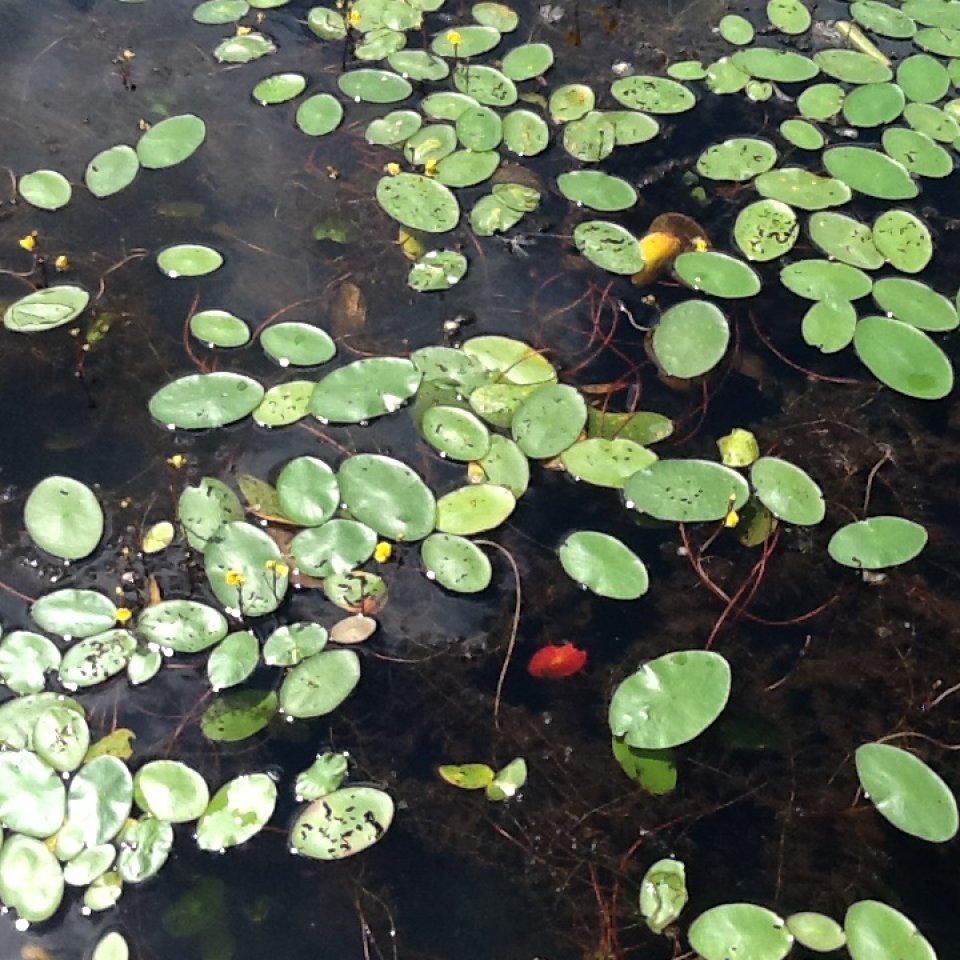
Water-net Algae
Water-net algae is a filamentous green algae known for its distinctive hollow, tube-like structure, which, upon closer inspection, forms a hexagonal net-like pattern. This algae thrives in nutrient-rich waters, where it spreads rapidly through fragmentation, often forming dense mats that can quickly overtake a pond. While it plays a role in aquatic ecosystems, excessive growth can reduce water quality, block sunlight, and interfere with recreational activities. Proper nutrient management and early intervention are key to controlling water-net algae and maintaining a balanced aquatic environment.

Water-thread Pondweed
Water-thread pondweed, also known as variable-leaf pondweed, is a perennial aquatic plant distinguished by its two distinct leaf types. The floating leaves are oval-shaped and have a leathery texture, while the submerged leaves are thin, flexible, and longer than those on the surface. This plant is commonly found in slow-moving or still waters, where it provides habitat and food for aquatic life. While beneficial to ecosystems, water-thread pondweed can spread rapidly in nutrient-rich environments, sometimes requiring management to prevent excessive growth that may interfere with water flow and recreation.
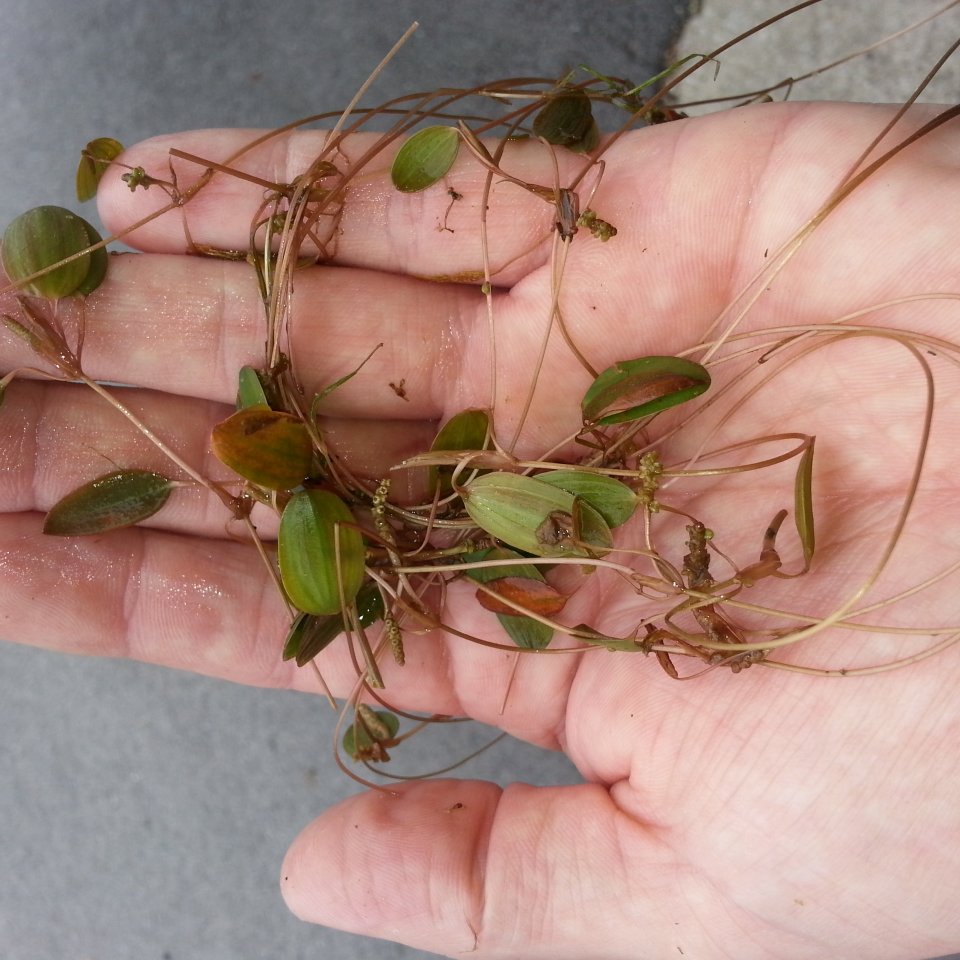
Watermeal
Watermeal is the world’s smallest flowering plant, appearing as tiny, green granules that float on the water’s surface. It thrives in calm, nutrient-rich freshwater environments and often grows alongside duckweed, forming dense surface scums. Reproducing rapidly through vegetative budding, watermeal can double its population in as little as two days, leading to oxygen depletion and reduced sunlight penetration. While it serves as a food source for waterfowl, unmanaged watermeal can create an impenetrable layer that blocks sunlight and disrupts ecosystems. Effective control methods, including aeration and nutrient management, are essential for preventing its spread and maintaining a healthy pond.
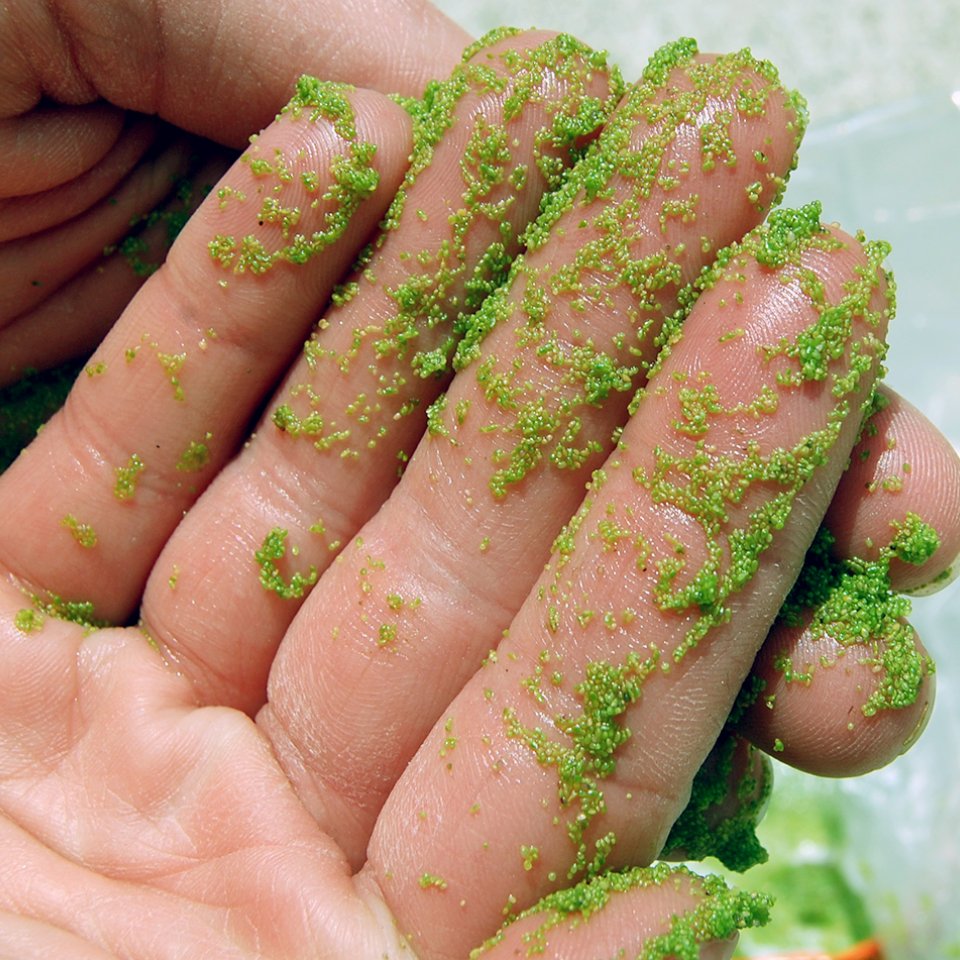
Willow Tree
Willow trees are fast-growing, deciduous trees commonly found along pond shorelines and wetland areas. Their extensive root systems allow them to thrive in moist soils, but if left unmanaged, they can spread rapidly, restricting water access and outcompeting other native vegetation. Over time, dense stands of willows can become difficult to control. Larger specimens may need to be cut before herbicide application to ensure effective management and prevent regrowth.


